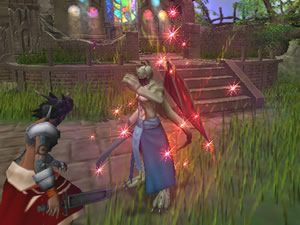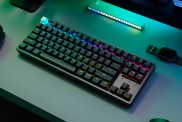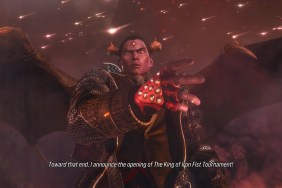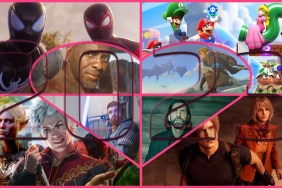Arc hits the awkward years.
The funny thing about the Arc The Lad RPG series is that even though the
lad, Arc, is only truly there for the first two games, he manages to live on phonetically.
Thus far, the series has starred Arc, Elc, and Alec.
Arc The Lad: Twilight of the Spirits, the first Arc game to hit a next-generation
console, continues this tradition in duplicate, starring two Human/Deimos halflings
separated at birth, Kharg and Darc. I think the next Arc The Lad series
should star a pirate named Arrrrgh The Bad.
The
stories of Kharg and Darc are told alternately in chapters, weaving together
two perspectives of a child raised among humans and one raised among the cutthroat
creatures, the Deimos. The events of Twilight of the Spirits take place
thousands of years after Arc III, using the events in the earlier stories
to explain the emergence of two species. Essentially, after the destruction
of the world, two new species rose from the ashes.
That explanation feels like a cheap way out. There are other references to
the Arc series, such as revised country names and appearances by two recurring
characters, but frankly, this could have been any game with just an Arc label
to help sell it.
The racial theme of Deimos versus Humans is pretty blatantly underlined and
serves as fuel for both sides of the story. While you can force certain thematic
readings out of the plot (like the irony of prophetic visions that ordain more
than one person as “the chosen one”), but there really isn’t anything deeper
here. Expect a generic but still entertaining story line with classic clichés
for a supporting cast.
The game plays like any standard RPG. Using a world map, you navigate between towns and areas. More points are opened up through the course of the story, offering the chance to freely go back and forth between points to level up.
Most of the non-town points will bring you right into a turn-based tactical battle. Previously, combat in the Arc games took place on square grids. Certain strategies could be used to bottleneck enemies, implement effective defensive and offensive positions and take advantage of special attacks that required unique character arrangements.
The battles now take place in a 3D environment. Instead of being able to move five squares, your character can move anywhere within a certain sized circle. Because of this, the arrangement strategy is made less important. There are multiple critical attacks that can happen when two characters stand near one another, but these happen randomly.
Arrangement is still important on the individual level, since some attacks require placing your character and thus his range of attack in just the right spot. For instance, a character with a bow and arrow has a long, thin range; when there are two beasts in a row, the most effective attack would be to stand in line with these opponents, shooting an arrow straight through both of them.
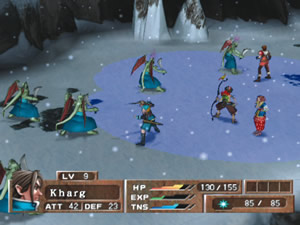 It’s
It’s
somewhat reminiscent of the movement system in Breath
of Fire: Dragon Quarter, but that game included a cool point system that
led to the appropriate checks and balances. Since there was a limited amount
of points to spend on both moves and attacks, more planning was required. The
further out you’d move, the less you’d be able to attack. Points could be spent
or conserved for the next turn. It made for great strategy.
Arc, on the other hand, keeps the attacks and moves as relatively separate
entities. With less emphasis on character placement tactics, these new Arc battles
simply don’t demand as much out of the player. The one check and balance between
attacks and movement occurs when opponents drop items, as item retrieval comes
at the cost of being stuck in one place for a turn. But past that, it’s just
not very compelling.
Still, the bulk of the game is enjoyable enough to keep most RPG gamers playing. You buy goods, upgrade equipment and fight bigger and badder enemies as it goes along, and while it isn’t very stunning, it gets the job done.
The visuals, however, don’t. Some of the character models and animation is
really weak, the kind of thing you’d expect in a PS2 game three years ago, but
not today. A weird grass effect is used to make the fields seem more organic,
but it doesn’t come off well. Each clump of grass moves in the same rhythm and
they add some unsightly jags to the picture. It’s like a big green barfy ocean.
For that matter, the jaggies seem to be everywhere. The environments are for
the most part decent and occasionally something nice sticks out, such as a stunning
waterfall in the distance, but by and large this isn’t a great-looking game.
The sound is also mediocre. One of the battle tunes sounds like an Irish
sea shanty mixed with 80’s guitar riffs. Very odd. At least the voice acting
is generally good enough to convey the necessary emotional range.
Arc The Lad: Twilight of the Spirits isn’t a bad game and most RPG
fans will find some good fun here. However, it just doesn’t live up to the older
games in the series. It features some interesting perspectives with its dual
stars, but its questionable delivery and lack of really compelling gameplay
holds it back.
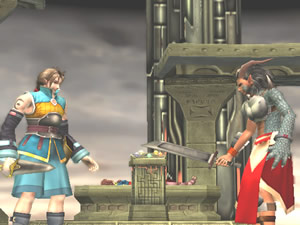
-
Dual perspective
-
Entertaining once it gets going
-
Bland combat system
-
Subpar delivery
-
Doesn¹t really feel like an Arc game in spirit
